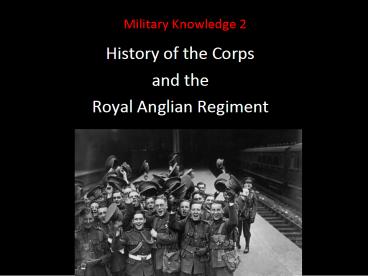Military Knowledge 2 - PowerPoint PPT Presentation
1 / 27
Title:
Military Knowledge 2
Description:
The Vikings are training in the UK to convert to the new Bulldog' armoured fighting vehicle. ... of a British Regiment's Colours, of the French 62nd Regiment. ... – PowerPoint PPT presentation
Number of Views:466
Avg rating:3.0/5.0
Title: Military Knowledge 2
1
Military Knowledge 2
- History of the Corps
- and the
- Royal Anglian Regiment
2
The Begining
- The cadet corps ( at this time known as an
Officer Training Corps) at Merchant Taylors
was officially created in the September of 1900, - although as early as 1896 there was reference to
a C Company (M.T.S) of the London Rifle Brigade. - Subscription was 5 shillings a term
3
Early Years
- Initially it was staffed by teacher- officers
alone but in 1910 the M.T. Company donated money
to pay for a permanent R.S.M. - Q.M.S. Lindsell had previously served 21 years
in the Royal Marines.
4
On parade 1912, bayonets fixed
5
The Great War 1914-1918
- The O.T.C.s were devoted to recruiting and
training young men for active service right from
the start. - By 1918 we had 1600 O.M.T.s and 13 Staff on
active service. - 251 killed
- 280 wounded
- 10 gassed
- 24 missing
- 30 taken prisoner
6
WW1 decorations
- 300 in total including 3 V.C.s, 38 D.S.O.s,
- 114 M.C.s
- Approximately, then, one in six killed and one
in six decorated. - A truly bloody but glorious record.
7
The V.C.s
- Lt J.C. Barrett V.C. Fifth Leicestershires
- In September 24th 1918, during the attack on
Ponruet, he rallied his men and stormed a machine
gun infested trench, personally disposing of two,
and inflicting many casualties. He continued to
fight even after he received a serious wound.
8
The V.C.s
- Midshipman G.L. Drewry V.C. R.N.R
- While serving in the Dardanelles, he was
responsible for a landing craft heading for the
beaches. During rough seas and hellish shellfire,
he managed to secure the craft at the beachhead,.
Even after receiving a serious head wound through
machine gun fire, he swam from vessel to vessel
with a rope.
9
The V.C.s
- Captain A.O. Pollard V.C., M.C, D.C.M. H.A.C.
- Joining in the ranks, he was decorated at Ypres,
then commissioned. - He rallied disorganised troops after his
battallion suffered heavy casualties due to shell
fire. Then, after a strong enemy force put in a
determined attack, through force of will he
organised and lead a counter attack, regained
what had been lost, and much more in addition.
10
WW2
- All boys over the age of 17 served in the local
home guard unit. Invasion was expected, and three
pill boxes were positioned near the lake. - When the air raid siren sounded during the night
Cadets were posted on the roof of the Great hall
to look out for fire bombs. - In 1940 the O.T.C. is renamed the Junior
Training Corps
11
evolution
- Up to this point the corps had been only an Army
organisation but in 1941 the R.A.F. Section was
formed under the title of the Air Training Corps.
12
Post War
- The Corps continued to prepare boys for national
service. - Soon after National service ended, in 1963, the
corps became fully voluntary. - In 1953 the Navy Section was created
- New CCF building opened in 1983, the same year
the Army Section started wearing the Royal
Anglian Khaki beret.
13
Recent Changes
- In 1993, because St Helens was considering
joining the M.T.s educational Trust, - 23 girls joined the CCF.
- 2007, Lt Col Colley returns to the CCF as
Commanding officer. His 25th year in the Corps.
He served previously from 1971-1995 in the Army
section.
14
The Royal Anglian Regiment
- The Army Sections sponsor regiment.
- This is an infantry regiment with an
illustrious history spanning over 300 years.
15
- The 1st Battalion are known as the Vikings
after the influence of the Nordic Warriors on the
Eastern part of the Regimental area. They have
recently returned from Afghanistan
16
Sniper section
17
The Vikings are training in the UK to convert to
the new Bulldog armoured fighting vehicle.
18
- The 2nd Battalions name the poachers is
inherited from the nickname of one of their
forbears, The Royal Lincolnshire Regiment who
adopted the name from the title of their
Regimental march, The Lincolnshire Poacher. they
are currently deployed in Germany as a Light Role
Battalion with 7 Armoured Brigade (The Desert
Rats).
19
Hard at work in Iraq 2006
20
(No Transcript)
21
(No Transcript)
22
Territorial Anglians
- The 3rd Battalion The Royal Anglian Regiment is
the Territorial Army Infantry Unit of East Anglia
. They are known as the Pompadours
23
(No Transcript)
24
The Royal Anglian cap badge
25
- Collar Badges
- The 1st Battalion wear The Royal Norfolk
Regiment's Britannia superimposed on The Suffolk
Regiment's Castle and Key of Gibralter. - The 2nd Battalion wear the Royal Lincolnshire
Regiment's Sphinx over the Northamptonshire
Regiment's Battle of Honour TALAVERA.
26
- Salamanca Eagle
- The 2nd Battalion 44th (East Essex) Regiment won
great glory for itself at the Battle of Salamanca
in 1812 when it captured the Eagle, the
equivalent of a British Regiment's Colours, of
the French 62nd Regiment. This is now worn as a
side badge by the 3rd Battalion.
27
The regimental quick march

